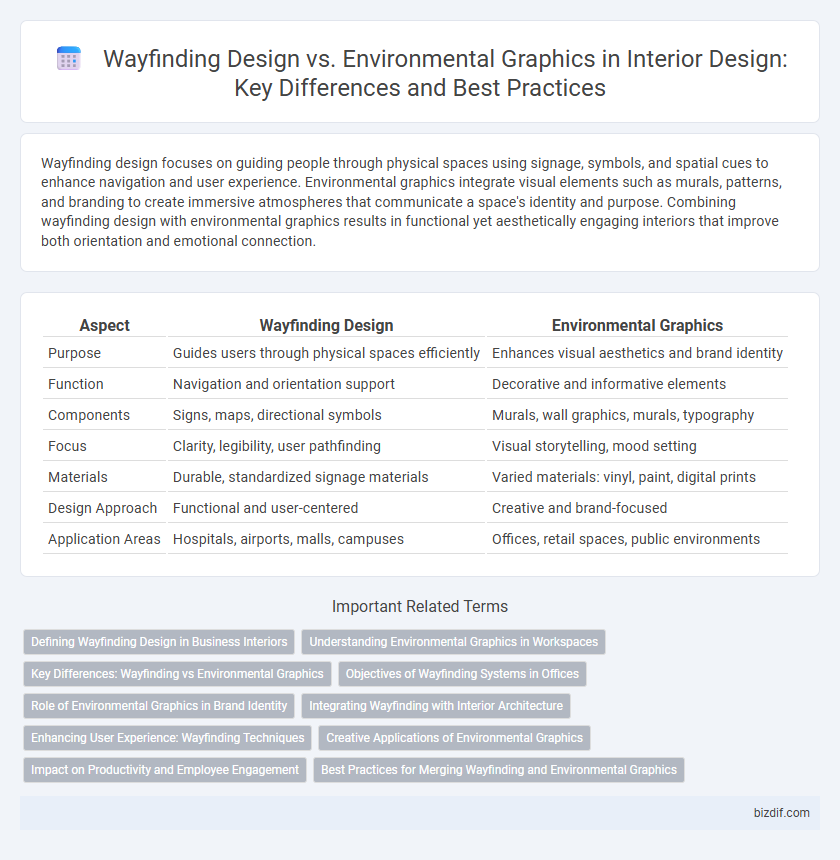Wayfinding design focuses on guiding people through physical spaces using signage, symbols, and spatial cues to enhance navigation and user experience. Environmental graphics integrate visual elements such as murals, patterns, and branding to create immersive atmospheres that communicate a space's identity and purpose. Combining wayfinding design with environmental graphics results in functional yet aesthetically engaging interiors that improve both orientation and emotional connection.
Table of Comparison
| Aspect | Wayfinding Design | Environmental Graphics |
|---|---|---|
| Purpose | Guides users through physical spaces efficiently | Enhances visual aesthetics and brand identity |
| Function | Navigation and orientation support | Decorative and informative elements |
| Components | Signs, maps, directional symbols | Murals, wall graphics, murals, typography |
| Focus | Clarity, legibility, user pathfinding | Visual storytelling, mood setting |
| Materials | Durable, standardized signage materials | Varied materials: vinyl, paint, digital prints |
| Design Approach | Functional and user-centered | Creative and brand-focused |
| Application Areas | Hospitals, airports, malls, campuses | Offices, retail spaces, public environments |
Defining Wayfinding Design in Business Interiors
Wayfinding design in business interiors focuses on creating intuitive navigation systems that guide employees and visitors efficiently through complex spaces using signage, symbols, and spatial cues. This design approach enhances user experience by reducing confusion and improving accessibility within corporate environments. Unlike environmental graphics that emphasize aesthetic and brand storytelling, wayfinding prioritizes functionality and clarity to support operational flow.
Understanding Environmental Graphics in Workspaces
Environmental graphics in workspaces enhance employee experience by visually communicating brand identity and organizational culture through integrated graphic elements. Unlike wayfinding design, which primarily focuses on navigation and spatial orientation, environmental graphics create a cohesive atmosphere that fosters engagement and productivity. Incorporating signage, murals, and digital displays, these graphics support a sense of place and reinforce workplace values.
Key Differences: Wayfinding vs Environmental Graphics
Wayfinding design focuses on creating navigational systems that help users efficiently find their way within a space through signage, maps, and spatial cues, emphasizing clarity and functionality. Environmental graphics integrate visual elements like murals, textures, and branding to enhance the aesthetic and emotional experience of an interior space while reinforcing the identity of the environment. The key difference lies in wayfinding's primary goal of orientation and guidance, whereas environmental graphics prioritize atmosphere, storytelling, and visual engagement.
Objectives of Wayfinding Systems in Offices
Wayfinding systems in offices aim to enhance spatial orientation by providing clear navigation cues that reduce confusion and improve efficiency. These designs prioritize user experience through intuitive signage, landmarks, and path clarity to streamline movement within complex office layouts. Unlike environmental graphics that focus on branding and aesthetic appeal, wayfinding emphasizes functional clarity to support productivity and accessibility.
Role of Environmental Graphics in Brand Identity
Environmental graphics play a critical role in brand identity by visually embedding the brand's personality and values within the physical space through colors, logos, and thematic motifs. Unlike wayfinding design, which primarily facilitates navigation, environmental graphics create immersive experiences that reinforce brand recognition and emotional connection. Strategic implementation of these graphics enhances user engagement and strengthens the cohesive visual language throughout an interior environment.
Integrating Wayfinding with Interior Architecture
Integrating wayfinding with interior architecture enhances spatial orientation by combining functional signage with architectural elements, creating intuitive navigation paths within complex environments. Environmental graphics complement wayfinding through visual storytelling, incorporating branding and thematic design to enrich user experience and reinforce identity. Harmonizing these disciplines ensures cohesive, legible spaces that improve accessibility and engagement in commercial, institutional, and public interiors.
Enhancing User Experience: Wayfinding Techniques
Wayfinding design leverages spatial cues, signage, and intuitive pathways to guide users seamlessly through complex interiors, enhancing navigation efficiency. Environmental graphics incorporate visual elements like murals, textures, and branding to create immersive atmospheres that support wayfinding by reinforcing spatial orientation. Integrating wayfinding techniques with environmental graphics significantly improves user experience, reducing confusion and increasing accessibility in public and commercial spaces.
Creative Applications of Environmental Graphics
Environmental graphics creatively merge art and information to enhance spatial storytelling, using graphics, colors, and materials that complement architectural elements while guiding user navigation. Wayfinding design, a subset, prioritizes functional clarity through signage and pathways, ensuring intuitive movement and spatial orientation within complex interiors. Creative applications of environmental graphics extend beyond navigation, transforming spaces into immersive experiences by integrating branding, cultural narratives, and sensory elements that enrich user engagement and identity.
Impact on Productivity and Employee Engagement
Wayfinding design streamlines navigation within workspaces, reducing time wasted searching for destinations and thereby boosting employee productivity. Environmental graphics enhance the aesthetic and cultural identity of the workspace, fostering a sense of belonging and increasing employee engagement. Together, these elements create an efficient and motivating environment that supports both functional and emotional needs of employees.
Best Practices for Merging Wayfinding and Environmental Graphics
Integrating wayfinding design with environmental graphics enhances spatial orientation by combining clear signage with visually engaging elements that reflect the brand identity and cultural context. Best practices include maintaining consistency in typography, color schemes, and iconography to ensure readability and intuitive navigation throughout the space. Utilizing durable materials and scalable design solutions allows for seamless updates and adaptability in dynamic environments such as airports, hospitals, and corporate campuses.
Wayfinding design vs Environmental graphics Infographic

 bizdif.com
bizdif.com